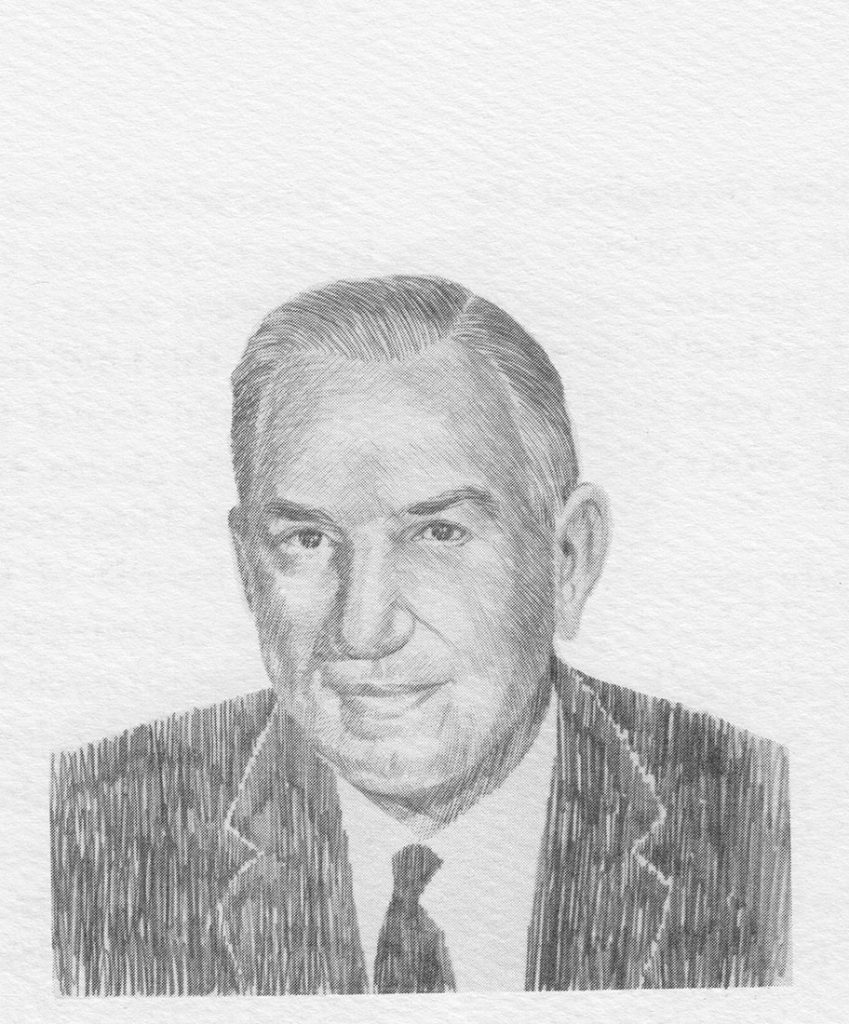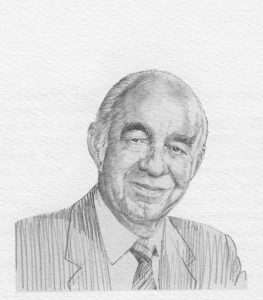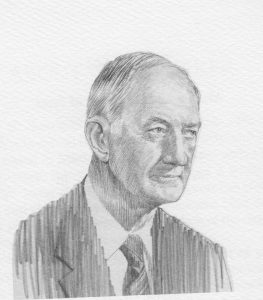Daniel Jeremiah Haughton’s oftrepeated advice was, ”You do the best you can with what you’ve got.” Perhaps his rise to national prominence as an astute and skillful leader in the aviation and aerospace industries and in civic affairs stemmed from the fact that he followed his own advice.
Dan Haughton, born September 7, 1911, grew up on a farm near the small town of Dora in Walker County, Alabama. The son of Gayle and Martha (Davis) Haughton, he graduated from West Jefferson County High School as valedictorian of his class. In 1929, he enrolled in The University of Alabama. To earn enough money to finance his education, he drove a school bus, transporting miners to and from work and children to and from school; worked in a garage morning and afternoons and in lunchrooms to pay for his lunch. During summer vacation, he earned $2.00 a day as a loader in a coal mine. About these work experiences, Dan Haughton later said, “I wouldn’t give up my experiences . . . for anything . . . I know how a guy feels when he works and he’s tired, and I know how to get tired and keep on going.”
When Dan Haughton graduated in 1933 with a B. S. degree in Accounting, he found few opportunities in depression-ridden Alabama. Thus, he went to California where he worked in construction companies until 1936 when his career in the aerospace industry began, as a cost accountant with the Consolidated Aircraft Corporation in San Diego.
In 1939, Dan Haughton joined Lockheed Aircraft Corporation in Burbank as a systems analyst and coordinator, with responsibilities for establishing procedures for accounting, industrial security, production controls, and manpower. His honesty, integrity, accuracy, common sense, and infinite capacity for work must have been quickly noticed. In 1941 he became assistant to the vice president of Lockheed’s Vega Aircraft Corporation subsidiary. His responsibilities included production planning, procurement, production, and deliveries. By 1943, his unusual management abilities were recognized by promotion to works manager of Vega Aircraft, with direct responsibility for its aircraft production programs. In early 1944, he was named assistant general works manager of Lockheed.
In 1946, Dan Haughton, who had established a reputation during World War II as a production specialist who could do equally well with men, machines, and money, was appointed assistant to Lockheed Aircraft’s vice president of manufacturing. In 1949, he became president of Lockheed’s subsidiary Airquipment Company and its Aerol Company, Inc. in Burbank.
In late 1950, in response to the need for bombers in Korea, the U.S. Air Force asked Lockheed to reopen a World War II bomber plant in Marietta, Georgia. Thus, in January 1951, a nucleus of 150 Lockheed employees from Burbank moved to Marietta to form the Georgia Division-among them, Dan Haughton as assistant general manager of the new division (now the Lockheed-Georgia Division). One year later he was named general manager of the Georgia Division and a vice president of Lockheed Aircraft Corporation. In 1956, he returned to Burbank to become executive vice president of the corporation. He became a member of the board of directors in 1958 and was elected president of the corporation in 1961. He became chairman of the board in 1967 and served until his retirement in 1976.
As Lockheed executive vice president, president, and then chairman, Dan Haughton oversaw the development of such famous planes as the high-altitude U-2 and SR-71 reconnaissance aircraft, the C-5 military transport, and the L-1011 Tristar commercial jetliner.
One of his greatest achievements was his success in keeping Lockheed from financial disaster in 1971 when Rolls-Royce went bankrupt while developing the engines for Lockheed’s L-1011 Jetliner. Using his patriarchal management style (which Fortune called “red-dirt southern courtliness”), he persuaded the British government to take over Rolls-Royce and continue the engine program; he arranged a $75 million credit package; and he pledged Lockheed assets as collateral when he convinced the U.S. government to guarantee a $250 million commercial loan from a group of 24 banks.
In recognition of his untiring efforts on behalf of Lockheed, Aviation Week in 1971 honored him, “for his indefatigable, courteous, frank, and successful campaign to keep his corporation afloat on the stormiest financial and technical waters the industry has ever seen.” The Greater Los Angeles Press Club named him “Headliner of the Year,” for the most delicate balancing act in the annals of modern American business . . . “in snatching his company from the brink of bankruptcy.”
In an unprecedented gathering, thousands of Lockheed employees and their families crowded the Los Angeles Convention Center for a “Day with Dan” to express their appreciation for his leadership. Dan Haughton had truly earned his unofficial nickname ”Uncle Dan.”
Dan Haughton’s leadership extended beyond the aviation and aerospace industry. He was also a leader in public service which benefited millions of Americans, locally and nationally. In civic and philanthropic affairs, he was known as one who could be counted on to give generously of his time and personal resources. He chaired funds for numerous causes such as Red Cross, United Way, and Boy Scouts. He devoted 20 years of ceaseless effort as a fundraiser, director, and national chairman for the Multiple Sclerosis Society to help fight the disease that in 1980 claimed his beloved wife, Martha Jean (nee Oliver), whom he had married in 1935.
Among the many honors Dan Haughton received were honorary Doctor of Law degrees from The University of Alabama (1962), George Washington University (1965), and Pepperdine University (1975); and an honorary doctor of science degree from Clarkson College of Technology (1973). Early in 1987, he was nominated and elected to the prestigious National Aviation Hall of Fame.
Other recognition included: the National Defense Transportation Association’s National Transportation Award (1965), the National Management Association’s Man of the Year (1966), Sales and Marketing Executives International Marketing Executive of the Year (1968), and the National Aviation Club Award of Achievement (1969).
Daniel Jeremiah Haughton died in Marietta, Georgia, on July 5, 1987. In a corporate management memo dated July 6, 1987, Larry Kitchen, chairman of the board and chief executive officer of Lockheed wrote, ‘With Dan Haughton’s death yesterday, Lockheed lost a fervent champion, the aerospace industry lost an esteemed leader, and every Lockheed employee lost a good friend.”
He is survived by one sister, Sarah Haughton Rodgers of Northport, Alabama, and twelve nieces and nephews.
Biographical information was derived from material compiled by James W. Jacobs & Associates, Inc., Sun City West, AZ, for the National Aviation Hall of Fame, Inc., 1987; from Lockheed publications-The Southern Star and Star Dusters Newsletter; and from articles in the Atlanta Constitution and the Marietta Daily Journal.




